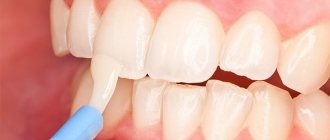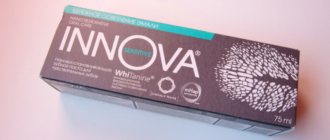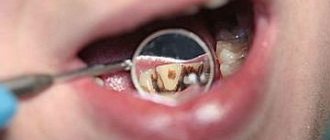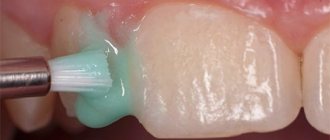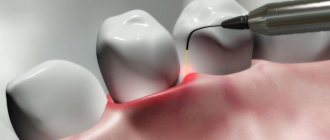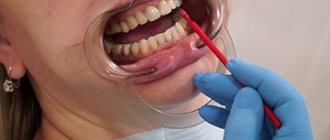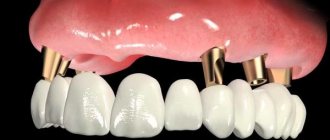Single tooth implantation is an excellent solution to aesthetic and physiological problems. The correct shape of the jaw is preserved, and accordingly its functionality. The artificial tooth matches the size and color of the enamel to all others and is installed anywhere in the dentition.
Implants allow you to restore the aesthetics and function of teeth and can be installed immediately after removal. The cost of implanting one tooth depends on several factors. It is influenced by:
- Volume and complexity of preparatory work . Typically, diagnostics, mouth sanitation, removal of carious formations, and bone grafting are carried out for an additional fee. Separately, fixation of a temporary crown and sinus lift are carried out.
- Crown material . His choice depends on the area of prosthetics and the patient’s budget. Crowns made of ceramics and zirconium dioxide have the greatest strength. Implantation of metal-ceramic crowns is cheaper. Prices for ceramics start from 27 thousand rubles, analogs from zirconium dioxide - from 30 thousand, from metal ceramics - from 23 thousand;
- Type/manufacturer of implants . Price for implants: budget - 15-30 thousand rubles, premium - 43-60 thousand rubles. Premium implants - Swedish Nobel, Swiss Astra-Tech, German Ankilos. Budget - Israeli Alpha-Bio, MIS, South Korean brands Implantium, Osstem.
Functions of the protective layer
Tooth enamel is the hardest tissue in the body, but at the same time, it is also the most fragile. It covers the other layers of the tooth, namely dentin and pulp. Enamel as a protection protects soft tissues from mechanical, temperature and chemical influences.
The protective layer is translucent and consists of various mineral substances. The structure depends on the characteristics of the body, the foods consumed and the process of assimilation of useful components.
On a note! Some people have a naturally thin protective layer on their teeth, making it susceptible to a variety of damage and disease.
The main function of enamel is to protect the soft tissues of the tooth from external irritants. It also ensures that the crown retains its shape, which makes full chewing possible. Due to the hardness of the enamel, food is crushed and bitten.
Characteristic symptoms
If a person’s tooth enamel begins to “peel off” or wear down, the following symptoms may appear:
- teeth sensitivity to various external irritants becomes higher;
Tooth sensitivity
- chips, microtraumas or cracks appear on the tooth enamel;
- the natural whiteness of the teeth is lost, as a result of which they become duller and acquire a yellow tint;
- painful sensations arise that can be either temporary or permanent. Often, the pain intensifies at night, which indicates damage to the dental pulp;
- Carious cavities form on the surface of teeth with damaged enamel.
Carious cavities
The manifestation of all of the above symptoms significantly worsens a person’s life, so if they are identified, you should immediately contact a dentist to restore the enamel. The sooner a patient seeks help, the greater the chance of successfully building up enamel and preventing serious consequences.
Electroodontodiagnosis (EDD)
Causes of destruction
Under the influence of a number of internal and external factors, the enamel wears out and becomes damaged. This affects the appearance, feel, and health of the entire oral cavity and gastrointestinal tract.
Injury to enamel is one of the causes of caries, pulpitis, darkening of teeth and their increased sensitivity.
What causes damage:
- poor oral hygiene;
- microflora disturbance, predominance of pathological microorganisms;
- diseases of the gastrointestinal tract (reflux esophagitis, gastritis);
- smoking, drinking energy drinks and mineral water with dyes;
- pathological bite, absence of one or more teeth;
- injuries and mechanical damage;
- bruxism, the habit of holding foreign objects in the teeth (matches, threads);
- eating sweet and sour foods;
- bleaching at home using aggressive abrasives and acids;
- lack of regular dental treatment;
- active accumulation of hard dental deposits.
The risk group includes people whose activities involve the possibility of injury (athletes, builders). Enamel can also be damaged by taking certain medications. The presence of prostheses is also a risk factor for the destruction of hard tissues.
Innovative method
Dental enamel implantation is restoration at the molecular level. The procedure is currently considered the most effective and high-quality.
The technique consists of applying a special agent (an analogue of the protein amelogenin), which is part of the protective layer, to the surface of the problem unit.
During the process of damage, this substance is lost, so during implantation it is artificially supplied. After the procedure, the tooth returns to its former shape and even becomes more attractive. The implanted tissue does not differ in color from the natural one.
On a note! Recovery continues for about a month after the procedure, but the tissue is able to fully perform all the functions of tooth enamel immediately.
This result is achieved due to the formation of a crystal lattice after the protein enters the pores.
Indications for implantation will be the following conditions:
- darkening of the tooth (when other methods do not work);
- fluorosis;
- mechanical damage;
- pathological bite (mild severity);
- irregular crown shape;
- large interdental spaces.
On a note! The procedure is a minimally invasive method and therefore does not require pain relief, which significantly narrows the list of contraindications.
The video shows the process of dental enamel implantation.
Stages of implantation of one tooth
Typically, in Moscow clinics, implantation of one tooth is performed in several stages:
- Free consultation . The patient is examined by a therapist, orthopedist, and implantologist. Doctors plan treatment and determine contraindications. They calculate the cost and duration of the procedures.
- Sanitation of the oral cavity . If necessary, caries and periodontitis are treated, and tartar is removed. In case of bone atrophy, bone grafting and sinus lifting are performed on the upper jaw.
- Direct implantation . If it is immediate, the titanium implant is fixed in the mouth after tooth extraction. Otherwise, the pin is implanted after an incision in the gum. With express implantation, it is administered in a minimally invasive way (the gums are not cut, but pierced).
- Temporary prosthetics . After implantation, an impression is made and the gum former is fixed. 3-7 days after the procedure, a plastic crown is mounted on the abutment. The patient wears it temporarily until the rod is completely implanted.
- Permanent prosthetics . After 3-6 months, if there are no complications, the denture material is not rejected, a permanent crown is fixed to the artificial tooth.
Implantation of one tooth is carried out in one or two stages. In the first case, the prosthesis is installed with an abutment at one dentist appointment. With the traditional approach, the titanium rod is fixed immediately. A few months later, the gum is cut again and the abutment is fixed.
Advantages and disadvantages
Experts attribute the following factors to the advantages of the technique:
- high aesthetics;
- elimination of cosmetic defects of any complexity;
- possibility of bite correction;
- return of soft tissue protection;
- painlessness;
- durability, restoration can last until the end of life.
The only disadvantage of implantation will be its high cost, compared to other restoration options. This is an innovative method of recovery, and it has no categorical contraindications or significant disadvantages.
Causes of development of tooth enamel erosion and methods of treating pathology.
Come here if you are interested in how dangerous cracks in tooth enamel are.
At this address https://www.vash-dentist.ru/protezirovanie/nesemnyie-p/stiranie-zubov.html we will talk about the treatment of pathological tooth abrasion.
Alternative methods
For minor defects in tooth enamel, enamel restoration methods such as remineralization, fluoridation, composite restoration, microprosthetics of front teeth with veneers and lumineers can be used. These methods already have their contraindications and disadvantages.
Remineralization
Remineralization is carried out to restore the balance of minerals. It is carried out by applying preparations containing fluoride and calcium to the problematic elements of the jaw.
The product can be applied to the teeth or placed in dental trays, which are placed on the bone organs of the upper and lower jaw.
The preventive procedure prevents the development of carious cavities and can be performed outside the walls of the clinic, for which individual mouth guards are made.
Indications:
- before bleaching;
- wedge-shaped defect;
- pregnancy period;
- before installing veneers and lumineers;
- enamel erosion and other non-carious defects.
Frequently used preparations for remineralization are Remodent and Rox gel. Their effect can be enhanced by supplementing the procedure with electrophoresis. This helps better penetration of substances such as magnesium, phosphorus, and calcium into hard tissues.
Fluoridation
The method is used to prevent caries. The procedure involves treating the problem units with a fluoride gel. A protective film forms on the enamel, which continues to release fluoride for some time.
Deep fluoridation is considered more effective, when the elements of the jaw row are covered with liquids containing calcium and fluorine.
The procedure is not performed for untreated caries. Before carrying out professional cleaning is carried out.
The benefit of the technique is to prevent caries, reduce tooth sensitivity, and preserve nutrients in the enamel, which makes it more durable.
Filling material
Artistic restoration with composites is performed for chips, cracks, stains, and abrasion of teeth. The technique is contraindicated only for night teeth grinding. Light-curing composite materials are used for restoration.
During the procedure, the dentist applies photopolymer mass in layers, creating the desired shape. During one visit, it is possible to restore several crowns at once.
The restoration can last more than 15 years, but polishing must be done every 2 years.
The purpose of the method of dental physiotherapy with calcium and the stages of the procedure.
In this publication we will talk about the peculiarities of the course of tooth necrosis.
Read here about the dangers of dental fluorosis in children.
Veneers and Lumineers
Veneers are thin composite and ceramic shells that are placed on pre-ground front teeth. Lumineers are distinguished by the fact that they are even thinner and do not require extensive grinding of the enamel.
Products are indicated for aesthetic defects, increased tooth abrasion, small chips and cracks, and unsatisfactory color. The technique is contraindicated for bruxism, pathological occlusion, caries and thin enamel.
Microprostheses can last up to 10 years, ultra-thin lumineers - up to 20 years. Using this method, you can restore the attractiveness of your teeth, completely transforming your smile line.
Recovery at home
Home methods for restoring enamel involve the use of medicated toothpastes, massage of the gums to improve tissue nutrition, the use of folk remedies, and adherence to healthy eating rules.
Folk remedies include rinsing the mouth with herbal decoctions, applying a mixture of garlic and beets to the gums, and applications with the addition of tea tree oil. To lighten enamel, you can use baking soda, hydrogen peroxide, and lemon juice.
On a note! Home remedies for lightening damage enamel and are highly discouraged. They give a temporary effect, after which the teeth darken even more.
Representatives of toothpastes for strengthening enamel:
- Splat Biocalcium;
- Glister;
- Lakalut Extra Sensitive;
- Colgate Sensitive Pro-Relief.
Gum massage is performed while brushing your teeth with a brush or finger. You need to make circular movements, several times near each tooth. This improves tissue nutrition, promoting normal blood circulation.
Products that are beneficial for enamel will be fresh vegetables and fruits, seafood, and fish. Dentists recommend eating an apple or carrot every day, which cleans crowns well.
To maintain dental health, it is important not to forget to rinse your mouth with water or a special mouthwash after each meal.
Prevention measures
To avoid the need for dental enamel implantation in the future, you need to regularly follow a few simple recommendations. This will reduce the likelihood of thinning the enamel. These recommendations include:
- careful adherence to the rules of oral hygiene. Experts recommend using mouthwash and dental floss daily. This will clean the tooth from plaque in places where a regular toothbrush is powerless;
Prevention of caries
- maintaining a proper diet. We are talking not only about the frequency and quantity of food consumed, but also about revising the diet. To avoid dental problems, you should, if possible, exclude energy and carbonated drinks, sweet foods and coffee from your diet. It is recommended to consume fresh vegetables and fruits daily;
Apples are good for teeth
- giving up bad habits that negatively affect the oral cavity and, in particular, the condition of the teeth. Prevention involves quitting smoking and excessive drinking;
- regular dental examinations. It is necessary to visit a doctor for preventive purposes not only when problems with teeth are identified, but also at ordinary times. After all, such examinations will allow us to identify possible problems or pathologies at an early stage of their development, which will significantly facilitate the treatment process;
The importance of regular dental check-ups
- give up chewing gum if you are an ardent fan. The fact is that chewing gum contains sugar, which damages tooth enamel.
Compliance with preventive measures on an ongoing basis will prevent not only thinning or damage to the enamel, but also many other dental diseases.
Price issue
| Method | Price (in rubles) |
| Fluoridation | Glubokoe - from 1200 Simple 1 tooth - from 300 |
| Remineralization | 1 jaw – from 1500 |
| Restoration with filling material | From 1000 |
| Veneers | From 10000 |
| Lumineers | From 25000 |
| Implantation | From 10000 |
Reviews
Enamel implantation is not suitable for everyone, but those who have tried this method of restoring teeth on themselves are convinced of the good aesthetics and reliability of the restoration.
But, along with positive opinions, this method also receives negative reviews. You can share your own impressions about the enamel implantation procedure in the comments below.
If you find an error, please select a piece of text and press Ctrl+Enter.
Tags: tooth enamel implantation
Did you like the article? stay tuned
Previous article
Causes of suture dehiscence after dental implantation and how to avoid the consequences
Next article
Frankly about the pros and cons of advanced dental implantation methods
Price
To obtain reliable information about the cost of enamel implantation, you need to show your teeth to a specialist.
- Today there are many methods of implantation, and only a dentist can tell which one is suitable for the patient.
- After the doctor examines the teeth and determines which implant is suitable for the patient, he will develop a special dental restoration program.
- The cost of the dentist's work will depend on the number of teeth that need restoration and the degree of damage to the tooth.
Of course, dental enamel implantation, the price of which is by no means cheap, is worth it to return your teeth to their high aesthetics and functionality.
| Enamel restoration method | Service cost |
| Application of fluoride-containing drugs | from 100 rub. for one tooth |
| Deep fluoridation of one tooth enamel | 600 rub. |
